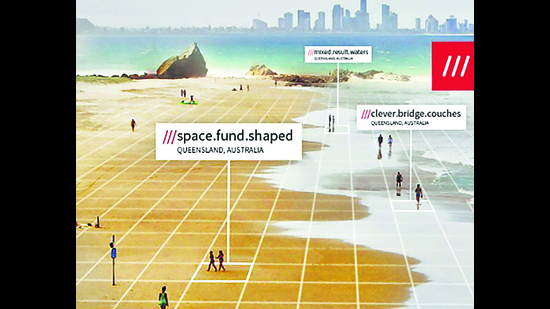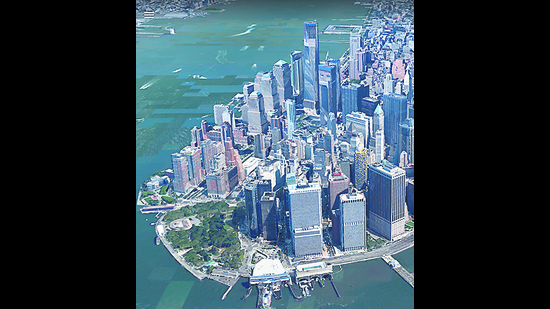3D visuals, hiking trails: See how maps and navigation apps are changing
There’s an app that watches the driver for signs of drowsiness; another lets users point to any 3-sq-m lot on the planet. Take a look.
There’s a tale that residents of Leonia, New Jersey, will likely share with their grandchildren. In 2018, police had to erect “Do Not Enter” signs on streets here, and hand out special passes to locals, as part of a crackdown on motorists flooding the town’s peaceful lanes. For months, the little enclave had become a recommended shortcut on navigation apps.

We are in a time of flux for digital navigation apps, and it’s not just the routes that are changing. New layers are on offer as alternatives to the clear market leader, Google Maps, evolve in order to compete.
Indian company MapMyIndia, for instance, now offers drivers lane guidance, down to speed limits and far better indication of whether or not to take an upcoming flyover.
Waze and HereWeGo offer more layered hyperlocal detail. Apps such as Citymapper, Trainline and Omio do a much better job of indoor guidance, including where to stand on a train platform, how the coaches might line up, and how to exit a railways station. Gaia offers to guide the user along paths less trodden, offering the additions of hiking maps and finer details such as slope angles and terrain guidance.
Regulation is changing in ways that could cause major shifts. New European Union guidelines, due to take effect in 2025, state that routing algorithms must avoid residential streets. This will likely have global impact, as technology companies tend to deploy one algorithm around the world.
Artificial intelligence (AI) is entering the frame, enabling new features and helping with the mindboggling task of keeping such apps updated.
Rohan Verma, CEO of MapmyIndia, says his company needs 1,200 people to keep its map of India up-to-date, with its 3.3 million sq km, 6.6 million km of road, and more than 50 million places or points of interest. It’s always a work in progress, particularly the points of interest, he says.
“We have mapped India digitally and continue to do so from vehicles, and now from drones,” he adds. Drones add dimensional data for physical structures such as flyovers and buildings, rivers and valleys. This helps the AI layer of the algorithm estimate the impact of natural phenomena such as monsoon flooding, when the need arises.
Google’s latest set of updates for Maps, released in October, meanwhile, uses an AI layer to fuse billions of Street View images to offer the user a more immersive view of their surroundings, even rendering buildings and landmarks in 3D.

In a dramatically different approach, American AI-led software company Affectiva offers to keep an eye trained on the driver. Since 2021, the Affectiva software integrated with the TomTom navigation system for cars uses a driver-facing camera to analyse signs of drowsiness (eye closure, yawning) and distraction (from other apps, or other people in the car). It then sounds an alert, in the form of an audio message suggesting that the driver take a break.
Rerouting…
In the quest for greater accuracy, UK tech company What3Words is taking a radically divergent approach. It’s slicing Earth into 57 trillion virtual 3-sq-m blocks.
Each square is given an address, in the form of a unique combination of three words. Users can share a location pin or address with others, including those using other navigation apps.
“Once you download the app, you have all of the world’s 57 trillion three-metre squares and three-word addresses on your phone,” says co-founder and CEO Chris Sheldrick. Just point the app to the square you need, and you can’t go wrong. Once the app is downloaded, because it’s a pre-set grid, it will also work without data connectivity, Sheldrick says.
What3Words has its eyes on a larger landscape: Partnerships with global automakers and integration with in-car infotainment systems. In India, Mahindra Auto and Tata Motors have already done this. As have Mercedes-Benz and logistics platforms BlueDart and DTDC.
What3Words is a novel approach, but for the rest, some foundational challenges remain. The world is changing all the time, and keeping even the most intelligent street view updated is an expensive, endless task. Which is probably why Amazon, Meta, Microsoft and TomTom united to form the Overture Maps Foundation (OMF) last year, in association with the Linux Foundation.
Earlier this year, OMF released its first dataset: an open-source map that can be used by anyone, to build or improve mapping, navigation or guidance apps. It is a work in progress and new versions will continue to be released.
In the map of navigation apps, then, we are here. The next few updates should be interesting.








